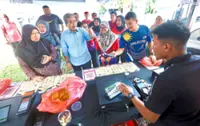Mohammad Muslim inserts samples into the staining machine. If and when this machine breaks down or requires maintenance, he and his colleagues will stain the samples manually as the back-up measure. — Photos: YAP CHEE HONG/The Star
Patients are usually unaware of what goes on behind the scenes after having their blood or tissue samples taken.
Medical lab scientists are the unsung heroes who analyse the samples and produce our test results and reports for our doctor to interpret.





